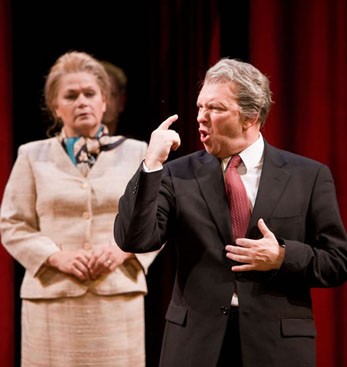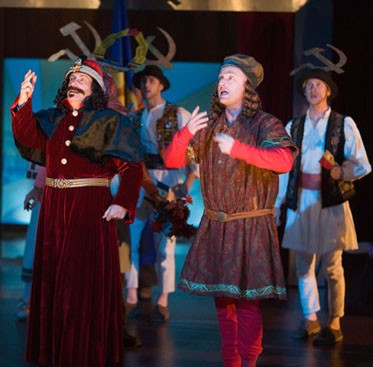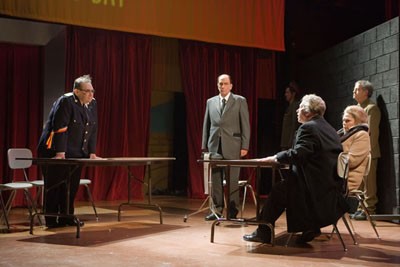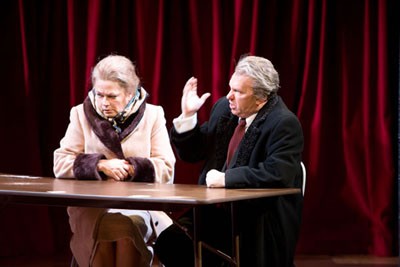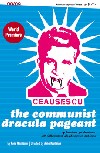The Communist Dracula Pageant World Premiere At American Repertory Theatre
Ceausescu Meets Vlad the Impaler About History
By: Mark Favermann - Oct 24, 2008
The Communist Dracula Pageant
By Anne Washburn
Directed by Anne Kauffman
Scenic Design by Mimi Lien
Costume Design by Christal Weatherly
Lighting Design by Tyler Micoleau
Sound Design by David Remedios
Original Music by J. Michael Friedman
Choreography by Doug Elkins
Voice and Speech by Nancy Houfek
The Cast
Nicolae Ceausescu Thomas Derrah
Elena Ceausescu Karen MacDonald
Vlad Tepes/
The Functionary Will LeBow
Ensemble: Remo Airaldi, Kaaron Briscoe, Sheila Carrasco, Shawn Cody, John Kuntz, Matthew Maher, James Senti, Josh Stamell, Roger K. Stewert
Pageanteers Adam Eli Clem, John M. Costa, Wayne Fritsche, Carrie Ann Quinn
1 Hour and 50 minutes with no intermission
Zero Arrow Street Theatre, Cambridge, MA
October 18 thru November 9
617-547-8300
http://www.amrep.org
"With the exception of rumor, everything here is fact; apart from all the colorful bits, it is imagination: this is how we create a history." From The Communist Dracula Pageant
Myth and history are similar in that they both tell stories. Sometimes history is about myth. Myth can also create history. But the whole truth may never be found in either. Just follow our own rather strange 2008 Presidential election season. Set in 1989 in one of the most brutal Eastern European regimes of the 20th Century, The Communist Dracula Pageant is about Romanian myth and history. This American Repertory Theatre World premiere is a satire on the forging of national identity and the power of a cruel dictator to rewrite the news and thus, script recent history. The mythic 15th Century vanquisher of the Turks, Vlad Tepes, the suggested role model for Bram Stocker's Dracula drops in to give advice and counsel.
The playwright, Anne Washburn, is an emerging voice in American contemporary theatre. Utilizing a playful love of language, she stories her narratives with vivid characterizations, a wry sense of humor, combining imagination with surprising and provocative storyline directions. The Communist Dracula Pageant is a prime example of her sensibility. Washburn draws from transcripts of the trials of fallen longtime dictator Nicolae Ceausescu and his co-conspirator wife Elena who ruled Romanian from 1965-1989 as well as Romanian folklore.
The playwright has set the play in three distinct time periods. The first is at the fall of the dictator and his wife in 1989. The second is at the height of their bloody regime when they sponsored kitschy pageants to glorify the Romanian nation. And the third travels back in time to the 15th Century to the reign of Vlad Tepes, the historical Count Dracula. The story interweaves each period.
As a group of protestors gather in the city of Timisoara, Ceausescu orders the army to fire on them. This ill-conceived decision leads the country to unite against the Ceausescus. Though the couple tries to fight to keep control, they cannot stop the rapid disintegration of their iron-grip. They are imprisoned, tried and executed in rapid succession. This Christmas Revolution as it became known is woven together with scenes involving Vlad Tepes and his traditional despotic philosophy of rule along with performances from the 1970s pageants celebrating Romanian national glory.
Though set during the Ceausescu dictatorship, it attempts to transcend national myths, geographical boundaries, and cults of personality. The play's theme, one of shaping historical myths and current affairs for personal political gain has a certain resonance during the waning days of a failed administration and the potential and possible pain of the current election.
The acting was exemplary. In every case, each actor played his or her role well. Particularly good was Karen Mac Donald as the scientific/scholar fraud Madam Elena Ceausescu and Will LeBow as the modern day layered Functionary and the seldom seen three-dimensional, costumed Vlad Tepes. At times LeBow ate the scenery, but this was exactly what should have happened with a character like Vlad. Matthew Meher played several roles. He had a unique presence and an unusual speaking voice, but both enhanced his performance.
A few negatives: the play had no intermission in almost two hours. It seemed a bit too long in one sitting. Another fault was that it was not clear when it ended. The audience seemed a bit surprised when the stage went black. Also, even though there were visual cues, time periods seemed to be somewhat confusing. The dream sequence format is challenging.
As usual with stagecraft, the American Repertory Theatre demonstrated great professionalism in the scenic design, with costumes, along with technical facility with audio and video aspects. Mimi Lien should be congratulated for her highly functional minimalist set, Christal Weatherly for her costumes, and Tyler Micoleau for his lighting design. Sound design by David Remedios was its usual superior quality. The original score by J. Michael Friedman was well integrated into the production.
The American Repertory Theatre is known for its edginess. It is a theatre company that has always taken theatrical chances. The Communist Dracula Pageant is one these dramatic risks or opportunities. Its full name is The Communist Dracula Pageant ---By Americans, for Americans; a play about the Romanian Revolution of 1989 with hallucinations, phosphorescence, and bears. This show was at the very least provocative. At times the dialogue was actually quite musical. The dramatic action seemed to be more song than dialogue. In fact, the best form for this show would have been as an opera, an opera of historic political scandal.
The Communist Dracula Pageant is not a simple play. It is dreamlike: odd events, difficult things, and visually strange happenings float in and out and don't quite fit together. The playwright's imagination keeps everything flowing. This play demonstrates that myth and history are so knotted that the truth of a situation is hard to figure out. Politics, power and reality seem like clearly defined elements, but as we know in the 21st Century, they are not. In reference to history and myth, this play declares that 20th Century and 15th Century despots were not very different. It asks whether or not we have learned anything.


